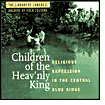

 |
Children of the Heav'nly King: Religious Expression in the Central Blue Ridge. The Library of Congress Archive of Folk Culture. Cambridge, MA: Rounder CD 1506/07, a registered trademark of Rounder Records Corp., 1998. 2 Compact Discs with 26 selections. Reviewed by William D. Isaacs III, for the Journal of Southern Religion.
Children of the Heav'nly King: Religious Expression in the Central Blue Ridge is an attempt to capture the modes of religious expression in the Central Blue Ridge region in the Appalachian Mountains, an area that extends from southwestern Virginia to northwestern North Carolina. A part of the Library of Congress Archive of Folk Culture, this set of compact discs, accompanied by a booklet that provides an introduction and lyrics to all selections, records the more traditional modes of religious expression like sermons, preaching, extemporaneous testimony, congregational and group singing, and prayer. Additionally, the album includes recordings of special events in the churches sampled, such as communion services, baptisms, revivals, and association meetings.
"Structured, well-researched, and thought-provoking sermons take a back seat to vociferous orators calling people back to holiness and urging congregants to "labor in the field of God," spreading the gospel to the "lost." |
Although these selections represent an eclectic collection songs and the spoken word, the various forms of expression primarily reflect the mode of religious life found in the multiple Baptist churches in the Central Blue Ridge region: e.g., Union Baptists, Primitive Baptists, Missionary Baptists, Regular Baptist, and Independent Baptists. While these denominations no doubt dominate the area that had a population of about 80,000 people in the late 1970s when these recordings were made, other denominations such as the Methodist and Presbyterian Churches are not represented at all in the collection. The only "minority" church represented comes by way of a single song by the Rev. Robert Akers, an evangelist and pastor of a Full Gospel Holiness Church. Thus, the subtitle, Religious Expression in the Central Blue Ridge, is somewhat misleading, since the full complexity of the religious landscape in the Central Blue Ridge region cannot be ascertained on the basis of these selections; but what the collection lacks in its representation of the various denominations in the region, it offsets through its sampling of selections drawn from the few African American churches of the region. In this way, the listener does have access to some variety of religious expression, styles of oration, and interpretations of music.
Listening to the selections on both CDs can be a challenging endeavor. The recordings of the music, a central mode of religious expression in the Central Blue Ridge and the general southern Appalachian region, are sometimes clear, rhythmic, and harmonic while other songs are performed on out-of-tune pianos without regard to standard musical time signatures, with voices that oftentimes cannot find the proper pitch. Some of the interviews and testimonies are incomprehensible because of the dialect, the ambiguous interpretations of the New Testament offered, and the colloquial expressions and imagery used. While some of the sermons are coherent, others are seemingly extemporaneous and delivered in a "stream-of-consciousness" style. Structured, well-researched, and thought-provoking sermons take a back seat to vociferous orators calling people back to holiness and urging congregants to "labor in the field of God," spreading the gospel to the "lost." The danger here is that such expressions lend themselves too easily to parody and the repetition of Southern religious stereotypes as old as H. L. Mencken. The question that remains to the listener is this: How can one make sense of an album that is comprised, in part, of the incomprehensible testimony of believers, songs sung to atonal accompaniment, and incoherent sermons that paradoxically provide the believer with structure, hope, and the way to a meaningful religious experience?
One way to address this question and to make sense of the album is to listen for recurring themes such as the desire to spread the gospel because of an anxiety that we are living in the last days. One of the more fundamental themes, however, is that of "sojourney," or the idea that people are only passing through this world on the way to their more permanent home in heaven. In songs, sermons, prayers, and testimonies, religious adherents point time and time again to the sinful and fleeting nature of this world and express their joy and enthusiasm for the afterlife. No matter how good or bad the song, sermon, testimony or other form of religious expression, by any standard the message is clear: labor for God; spread the gospel; and live a holy life, for heaven will be the reward. Holding firmly to the idea of sojourney, believers in the Central Blue Ridge Mountains find hope and meaning in various forms of religious expression that give the believer a temporary glimpse of their eternal reward.
In addition to serving as an expression of folk culture in the Central Blue Ridge Mountains, this CD set provides a rich source of information for scholars who study religious history in America. More specifically, it opens the door for a discussion of religion and region in America by offering primary documentation for a religion that is clearly influenced by its geographical isolation and unique local culture. Consequently, Children of the Heav'nly King: Religious Expression in the Central Blue Ridge provides a helpful case study for and makes a solid contribution to the exploration of the intersection between religion and culture in southern Appalachia in particular or even the South or the United States in general.
William D. Isaacs III, Florida State University
© 1998-2004 by The Journal of Southern Religion. All rights reserved. ISSN 1094-5234